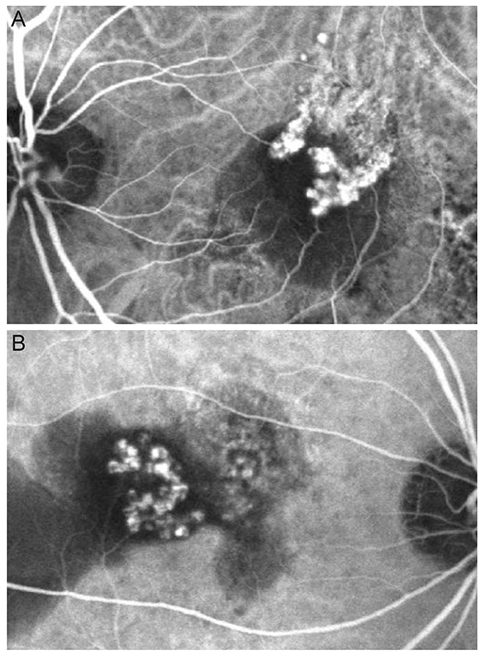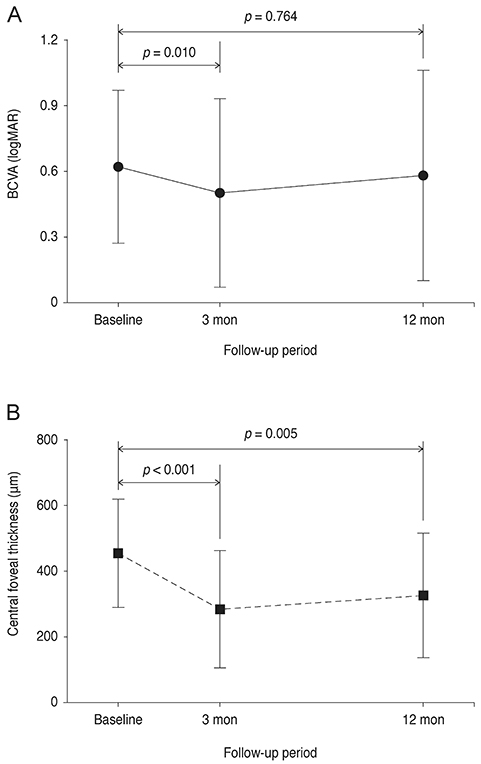Korean J Ophthalmol.
2016 Aug;30(4):272-279. 10.3341/kjo.2016.30.4.272.
Intravitreal Anti-vascular Endothelial Growth Factor for Treating Polypoidal Choroidal Vasculopathy with Grape-like Polyp Clusters
- Affiliations
-
- 1Department of Ophthalmology, Konyang University College of Medicine, Daejeon, Korea.
- 2Department of Ophthalmology, Kim's Eye Hospital, Konyang University College of Medicine, Seoul, Korea. kimoph@gmail.com
- KMID: 2373987
- DOI: http://doi.org/10.3341/kjo.2016.30.4.272
Abstract
- PURPOSE
To evaluate 12-month outcomes of anti-vascular endothelial growth factor (VEGF) therapy for polypoidal choroidal vasculopathy (PCV) with grape-like polyp clusters.
METHODS
This retrospective observational study included 23 eyes of 23 patients who were newly diagnosed with PCV with grape-like polyp clusters, and who were subsequently treated with anti-VEGF monotherapy. The study compares the best-corrected visual acuity (BCVA) of the patients at diagnosis, at 3 months, and at 12 months after diagnosis. In addition, 12-month changes in BCVA values were compared between cases with subfoveal or juxtafoveal polyps and cases with extrafoveal polyps.
RESULTS
The baseline, 3-month, and 12-month logarithm of the minimal angle of resolution BCVA was 0.62 ± 0.35, 0.50 ± 0.43, and 0.58 ± 0.48, respectively. Compared to the baseline, patient BCVA was not significantly different at 12 months after diagnosis (p = 0.764). Six eyes (26.1%) gained ≥0.2 logarithm of the minimal angle of resolution BCVA. In cases with subfoveal or juxtafoveal polyps, BCVA values at baseline and at 12 months after diagnosis were 0.66 ± 0.37 and 0.69 ± 0.53, respectively. In cases with extrafoveal polyps, the values were 0.54 ± 0.33 and 0.37 ± 0.31, respectively. Changes in BCVA values were significantly different between the two groups (p = 0.023).
CONCLUSIONS
Although anti-VEGF therapy has favorable short-term efficacy for treating PCV with grape-like polyp clusters, long-term visual improvements are generally limited in the majority of afflicted eyes. The presence of subfoveal or juxtafoveal polyps may suggest unfavorable treatment outcomes.
Keyword
MeSH Terms
-
Aged
Angiogenesis Inhibitors/*administration & dosage
Choroid/blood supply/*diagnostic imaging
Choroidal Neovascularization/diagnosis/*drug therapy
Female
Fluorescein Angiography
Follow-Up Studies
Fundus Oculi
Humans
Intravitreal Injections
Male
Polyps/diagnosis/*drug therapy
Retrospective Studies
Tomography, Optical Coherence
Vascular Endothelial Growth Factor A/*antagonists & inhibitors
Angiogenesis Inhibitors
Vascular Endothelial Growth Factor A
Figure
Reference
-
1. Oishi A, Kojima H, Mandai M, et al. Comparison of the effect of ranibizumab and verteporfin for polypoidal choroidal vasculopathy: 12-month LAPTOP study results. Am J Ophthalmol. 2013; 156:644–651.2. Cheng CK, Peng CH, Chang CK, et al. One-year outcomes of intravitreal bevacizumab (avastin) therapy for polypoidal choroidal vasculopathy. Retina. 2011; 31:846–856.3. Hikichi T, Higuchi M, Matsushita T, et al. Results of 2 years of treatment with as-needed ranibizumab reinjection for polypoidal choroidal vasculopathy. Br J Ophthalmol. 2013; 97:617–621.4. Lee SY, Kim JG, Joe SG, et al. The therapeutic effects of bevacizumab in patients with polypoidal choroidal vasculopathy. Korean J Ophthalmol. 2008; 22:92–99.5. Chan WM, Lam DS, Lai TY, et al. Photodynamic therapy with verteporfin for symptomatic polypoidal choroidal vasculopathy: one-year results of a prospective case series. Ophthalmology. 2004; 111:1576–1584.6. Inoue M, Arakawa A, Yamane S, Kadonosono K. Long-term outcome of intravitreal ranibizumab treatment, compared with photodynamic therapy, in patients with polypoidal choroidal vasculopathy. Eye (Lond). 2013; 27:1013–1020.7. Tomita K, Tsujikawa A, Yamashiro K, et al. Treatment of polypoidal choroidal vasculopathy with photodynamic therapy combined with intravitreal injections of ranibizumab. Am J Ophthalmol. 2012; 153:68–80.e1.8. Lee JH, Lee WK. Anti-vascular endothelial growth factor monotherapy for polypoidal choroidal vasculopathy with polyps resembling grape clusters. Graefes Arch Clin Exp Ophthalmol. 2016; 254:645–651.9. Lee WK, Kim KS, Kim W, et al. Responses to photodynamic therapy in patients with polypoidal choroidal vasculopathy consisting of polyps resembling grape clusters. Am J Ophthalmol. 2012; 154:355–365.e1.10. Sho K, Takahashi K, Yamada H, et al. Polypoidal choroidal vasculopathy: incidence, demographic features, and clinical characteristics. Arch Ophthalmol. 2003; 121:1392–1396.11. Uyama M, Wada M, Nagai Y, et al. Polypoidal choroidal vasculopathy: natural history. Am J Ophthalmol. 2002; 133:639–648.12. Lai TY, Lee GK, Luk FO, Lam DS. Intravitreal ranibizumab with or without photodynamic therapy for the treatment of symptomatic polypoidal choroidal vasculopathy. Retina. 2011; 31:1581–1588.13. Tsujikawa A, Ooto S, Yamashiro K, et al. Treatment of polypoidal choroidal vasculopathy by intravitreal injection of bevacizumab. Jpn J Ophthalmol. 2010; 54:310–319.14. Wakabayashi T, Gomi F, Sawa M, et al. Intravitreal bevacizumab for exudative branching vascular networks in polypoidal choroidal vasculopathy. Br J Ophthalmol. 2012; 96:394–399.15. Gemmy Cheung CM, Yeo I, Li X, et al. Argon laser with and without anti-vascular endothelial growth factor therapy for extrafoveal polypoidal choroidal vasculopathy. Am J Ophthalmol. 2013; 155:295–304.e1.16. Hou J, Tao Y, Li XX, Zhao MW. Clinical characteristics of polypoidal choroidal vasculopathy in Chinese patients. Graefes Arch Clin Exp Ophthalmol. 2011; 249:975–979.17. Parodi MB, Iacono P, La Spina C, et al. Intravitreal ranibizumab for naive extrafoveal choroidal neovascularization secondary to age-related macular degeneration. Retina. 2014; 34:2167–2170.18. Saito M, Kano M, Itagaki K, et al. Switching to intravitreal aflibercept injection for polypoidal choroidal vasculopathy refractory to ranibizumab. Retina. 2014; 34:2192–2201.19. Yamashita M, Nishi T, Hasegawa T, Ogata N. Response of serous retinal pigment epithelial detachments to intravitreal aflibercept in polypoidal choroidal vasculopathy refractory to ranibizumab. Clin Ophthalmol. 2014; 8:343–346.20. Kang HM, Koh HJ. Long-term visual outcome and prognostic factors after intravitreal ranibizumab injections for polypoidal choroidal vasculopathy. Am J Ophthalmol. 2013; 156:652–660.21. Fung AE, Lalwani GA, Rosenfeld PJ, et al. An optical coherence tomography-guided, variable dosing regimen with intravitreal ranibizumab (Lucentis) for neovascular age-related macular degeneration. Am J Ophthalmol. 2007; 143:566–583.22. Rauch R, Weingessel B, Maca SM, Vecsei-Marlovits PV. Time to first treatment: The significance of early treatment of exudative age-related macular degeneration. Retina. 2012; 32:1260–1264.23. Arias L, Armada F, Donate J, et al. Delay in treating age-related macular degeneration in Spain is associated with progressive vision loss. Eye (Lond). 2009; 23:326–333.24. Koh A, Lee WK, Chen LJ, et al. EVEREST study: efficacy and safety of verteporfin photodynamic therapy in combination with ranibizumab or alone versus ranibizumab monotherapy in patients with symptomatic macular polypoidal choroidal vasculopathy. Retina. 2012; 32:1453–1464.25. Koh AH. Expert PCV Panel. Chen LJ, et al. Polypoidal choroidal vasculopathy: evidence-based guidelines for clinical diagnosis and treatment. Retina. 2013; 33:686–716.
- Full Text Links
- Actions
-
Cited
- CITED
-
- Close
- Share
- Similar articles
-
- Peripapillary Choroidal Thickness Change of Polypoidal Choroidal Vasculopathy after Anti-vascular Endothelial Growth Factor
- Long-term Results of Reduced-fluence Photodynamic Therapy Combined with Intravitreal Anti-Vascular Endothelial Growth Factor for Polypoidal Choroidal Vasculopathy
- A Case of Polypoidal Choroidal Vasculopathy and Serous Retinal Detachment in a Bilateral Dome-shaped Macula
- A Comparison of Efficacies of Aflibercept and Ranibizumab, Depending on the Angiographic Classification of Polypoidal Choroidal Vasculopathy
- Intravitreal Anti-vascular Endothelial Growth Factor for Newly Diagnosed Symptomatic Polypoidal Choroidal Vasculopathy with Extrafoveal Polyps





